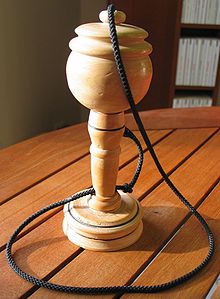Cup-and-ball
 Frenchbilboquet | |
| Playing time | About 45 seconds to a few minutes per round |
|---|---|
| Chance | Low |
| Age range | 2+ |
| Skills | Hand-eye coordination |
Cup-and-ball(orball in a cup) orring and pinis a traditional children's toy. It is generally a wooden handle to which a small ball is attached by a string and that has one or two cups, or a spike, upon which the player tries to catch the ball. It is popular in Spanish-speaking countries, where it is called by a wide number of names (includingbolichein Spain,Capiruchoin El Salvador andbaleroin most of Hispanic America), and was historically popular in France as thebilboquet.A similar toy with three cups and a spike calledkendamais very popular in Japan and has spread globally in popularity.
History[edit]
The game was created in the 14th century and has been improved in different ways since then.[citation needed]
Americas[edit]

In North America it was both a child's toy and a gambling mechanism for adults, and involved catching a ring rather than a ball. In some Native American tribes it was even a courtship device, where suitors would challenge the objects of their interest to a polite game of ring and pin.[citation needed]TheMohavevariant of the game included up to 17 extra rings attached to the cord, and game scoring involved differing point values assigned to different rings.[1]Other variants include those played by theInuitof what is nowLabrador,with a rabbit's skull in place of the ball, with extra holes bored into it, which had to be caught on the handle like a skewer; and those that used balls of grass or animal hair.[1]Ring and pin games in general were known as ᐊᔭᒐᒃajagak,ayagak,and ᐊᔭᖁᒃᑐᒃajaquktukinInuit dialects.[2]
France[edit]

The cup-and-ball is noted in France as early as the sixteenth century.[1]The game was played by KingHenry III of Franceas historical records note, though his playing was considered evidence of his mental instability.[3]After his death, the game went out of fashion, and for a century the game was only remembered by a small number of enthusiasts[citation needed]such as the Marquis de Bièvre.[4]
The game had its golden age during the reign ofLouis XV— among the upper classes people owned baleros made of ivory. Actors also sometimes appeared with them in scenes. The game was very popular in the 18th and 19th centuries.Jean-Jacques Rousseaumentions the game early in hisConfessionswhen stating his reservations about idle talk and hands, saying "If ever I went back into society I should carry a cup-and-ball in my pocket, and play with it all day long to excuse myself from speaking when I had nothing to say."[5]
Iberian world[edit]
The game is very popular in the Spanish and Portuguese diaspora. The name varies across many countries — inEl SalvadorandGuatemalait is calledcapirucho;inArgentina,Ecuador,Colombia,Mexico,andUruguayit is calledbalero;inSpainit isboliche;inPortugalandBrazilit is calledbilboquê;inChileit isemboque;inColombiait is calledcoca;and inVenezuelathe game is calledperinola.[6]
In 1960, American lexicographer Charles Keilus (1919-1997) documented the termzingo payafor a cup-and-ball game in Tijuana, Mexico, and formed the Zingo Paya Society in Los Angeles to promote the toy and its collection.[7][importance?]
England[edit]
This game was also popular in England during the early 19th century, asJane Austenis reputed to have excelled while entertaining her nephew in a game calledBilbo Catcher.[citation needed]
There is one picture at the National Portrait Gallery of a young girl playing the game. It appears to be a copy of a painting from Philip Mercier although the original painting has not been found.[8]Unlike other 18th century toys, which are found repeatedly in artwork, cup and ball games are rare with only two known pictures, one copied from the other.
Japan[edit]
The game ofkendamais believed to have arrived in Japan in the 18th century,[citation needed]and the game underwent significant modernization and standardization in the early 20th century, becoming internationally popular in the 21st century.
Germany[edit]
In 2011, a German company, TicToys, began to create a toy with the name Ticayo. Yomega, an American company which is famous for theiryo-yosandkendamas,began to sell Ticayos, in which they popularized the said toy.[9]
Gameplay[edit]
The main goal of the game is to get the ball into the cup. While the concept is very easy, mastering the game can sometimes be challenging.
There are several styles of gameplay in the Latin world such asla simple,la doble,la vertical,la mariquita.
References[edit]
- ^abcAndrew Leibs (2004).Sports and Games of the Renaissance.Greenwood Publishing Group. pp. 84, 147–148.ISBN0-313-32772-6.
- ^Kendall Blanchard (1 January 1995).The Anthropology of Sport: An Introduction.ABC-CLIO. pp. 148–.ISBN978-0-89789-330-5.
- ^Martha Walker Freer (1888).Henry III, King of France and Poland: His Court and Times. From Numerous Unpublished Sources, Including Ms. Documents in the Bibliotheque Impériale, and the Archives of France and Italy, Etc.Dodd, Mead and Company. p. 10.-"it is lamentable to read of the pitiful imbecility which could induce the king, the day following his indignant protest, to sally forth from the Louvre at the head of a disorderly troop, and to parade the streets of the capital playing with a cup-and-ball.
- ^The Strand Magazine.G. Newnes. 1907. p. 464.
- ^Rousseau, Jean-Jacques.The Confessions of J. J. Rousseau.Project Gutenberg: Privately Printed for the Members of the Aldus Society London, 1903.Retrieved18 October2014.
- ^Civila."El balero"(in Spanish). Open Publishing. Archived fromthe originalon 14 September 2008.Retrieved3 September2008.
- ^"The Zingo Paya Society".zingopaya.com.Retrieved13 January2016.
- ^"NPG D5676; Charlotte Mercier ('Miss playing with Cup and Ball') - Portrait - National Portrait Gallery".npg.org.uk.Retrieved13 January2016.
- ^"Kendama Pro Yomega".Yoyoplay.Retrieved16 May2023.

